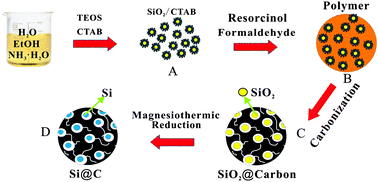Novel mesoporous Si@C microspheres as anodes for lithium-ion batteries
Abstract
In this paper, we demonstrate the design and synthesis of novel mesoporous Si@C microspheres as anode materials for high-performance lithium-ion batteries. SiO2 nanoparticles modified with hexadecyl trimethyl ammonium bromide are enveloped within resorcinol–formaldehyde polymer microspheres which form in the ethanol–water–ammonia system. Mesoporous voids between Si nanoparticles and the carbon framework are generated after carbonization at 800 °C and magnesiothermic reduction at 650 °C. The resultant Si@C microspheres show regular spherical shapes with a mean diameter of about 500 nm, a mesopore size of 3.2 nm and specific surface areas of 401–424 m2 g−1. Mesoporosity of Si@C microspheres effectively buffers the volume expansion/shrinkage of Si nanoparticles during Li ion insertion/extraction, which endows mesoporous Si@C microspheres with excellent electrochemical performance and cycle stability when they are used as lithium-ion battery anode materials. A typical sample of mesoporous Si@C microspheres presents a specific capacity of 1637 and 1375 mA h g−1 at first discharge and charge under a current density of 50 mA g−1. After 100 cycles, the charge capacity remains 1053 mA h g−1 with a coulombic efficiency of 99%, showing good cycle stability of the anode. This finding highlights the potential application of mesoporous Si@C microspheres in lithium-ion battery anode materials.


 Please wait while we load your content...
Please wait while we load your content...